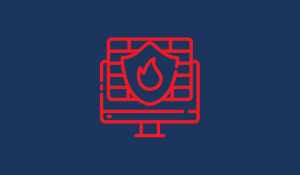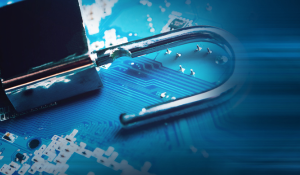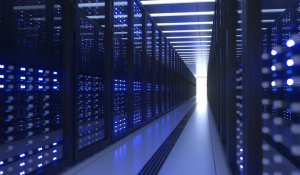
Are you ready to fortify your digital defenses and safeguard your network from cyberattacks? Look no further than the network firewall. A formidable barrier stands between your valuable information and the potential threats of the digital landscape. This barrier allows you to navigate with confidence and peace of mind.
| TABLE OF CONTENT |
We will clarify definition of firewall, show you its most popular times, how does it work. Additionally, we will provide you with 8 best practices for effective usage, empowering you to maximize the protection of your digital assets. Let's dive in and fortify your cybersecurity against cyberattacks!
A. What is a firewall?
First, we should explain the basics and answer the question; what is a firewall? A firewall is a computer security network that monitors, controls, and restricts in- and outgoing internet traffic. It also decided whether to authorize or block a specific traffic defined by a set of security rules.
The main reason of it, is to set a barrier between your internal network and external traffic to block malicious problems such as viruses or potential hacking attacks. It can be seen as a gatekeeper which lets or prohibits web activity to your private network.
Firewall: A definition
In the realm of computing, a firewall functions as a network security mechanism, overseeing and regulating the flow of incoming and outgoing network data according to predefined security protocols. Ordinarily, a firewall creates a protective boundary between a reliable network and an unverified network, such as the Internet.
3 key differences between firewall and antivirus software
Firewalls and antivirus software’s are providing security to our systems, but there are slight differences between them.
- Antivirus software is a component of network security to provide security from malicious software. On the other hand, firewall is a necessary software or firmware which prevents unauthorized access to a network.
- Antivirus software is based on detection, identification and removal. Firewall checks in- and outgoing traffic which blocks threats.
- You can use firewall on different settings such as personal, enterprise or even both. They are often built-in options on many software such as Windows, Linux or Mac.
Where can you find a firewall?
- Operating systems: Most modern operating systems, such as Windows, macOS and Linux, have built-in software firewalls. These firewalls can often be activated, configured and managed via the system settings.
- Security software: Third-party antivirus and security suites often offer firewall capabilities as well. This software can provide additional layers of protection by monitoring and blocking or allowing outgoing and incoming data connections.
- Routers and network hardware: Many routers have built-in hardware firewalls that can monitor and control traffic between your local network and the Internet. These firewalls can be configured in the router's settings.
- Corporate networks: In corporate environments, specialised firewall devices are often used to monitor and control network traffic. These devices can be part of a broader network security strategy.
B. 7 types of firewalls
Firewalls can be based on a software or a hardware however, the best practice is to have both. A software one is the one which is installed on the computer or the server. It is easier to set up and maintain and it has smaller effect on the user experience.
On the hand, hardware firewall is located between the network and devices, and it is the physical hardware, installed between them. But it requires skilled employees to install it and manage it.
They are also based on their filtering methods, structure, and their functionality. Find out more about them:
- Packet Filtering – examinates source packets addresses and disallows them from passing through.
- Proxy Service Firewall – defends the network by filtering messages at the application level. It works as an intermediary between two end system.
- Stateful Inspection – either allows or blocks network traffic based on its state, port and protocol by filtering based on the administrator defined rules.
- Next-Generation Firewall – includes deep packet inspection which allows it to examine the data and its packet.
- Unified Threat Management Firewall – uses an integration of stateful inspection firewall, intrusion prevention, and antivirus as well as other additional services such as a cloud management.
- Threat-Focused Next Generation Firewalls– detects evasive or suspicious behaviour by advanced threat detection, network, and endpoint correlation.
- Firewall as a Service - is a cloud-based security solution that provides scalable and centralized firewall protection, enabling organizations to secure their networks without relying on traditional on-premise hardware.
What is a hardware firewall?
A "hardware software" is not a specific technical name or term. It seems to be more of a confusion or combination of the terms "hardware" and "software", both of which are basic components of computers and electronic devices.
- Hardware: This refers to the physical components of a computer or electronic device. This includes things like processors, memory, hard drives, monitors, keyboards, mouse devices and more. Hardware is the actual material that computers and devices are built from.
- Software: These are the non-physical instructions or programs that run on the hardware to perform specific tasks. Software includes operating systems, application programs, drivers and more. They are the instructions that control hardware and make it perform certain functions.
C. Firewall: what is it important for your cybersecurity?
So probably now you might be wondering, why firewall is important for your cybersecurity. Firstly, a network without any protection is exposed to any traffic, both safe and malicious, to access your system. And they will provide a protection to your private or business computer.
- They monitor network traffic by analysing it and levering rules. With the set of rules, it filters against potential phasing attack, malware, ransomware, identity theft, social engineering attack and silent hacker attacks.
- They offer proactive protection while also going beyond classic defence mechanisms used in cybersecurity.
- Nowadays, they offer more control, better transparency and advanced ability to manage data and ingoing information.
- This defence mechanism has a simpler infrastructure so IT teams can expand their policies.
- Firewalls are providing faster response time as well as easy updates.
D. What does a firewall work?
A network firewall analyses incoming traffic by the set of special parameters to find unsecured or suspicious sources to prevent any possible attacks or viruses. It creates ‘ports’ for incoming traffic and differentiates it between good and bad packets which later is allowed or blocked.
A packet in IT security refers to a data packet. It is structured for internet transfer and contains information about itself. Firewall detects whether the packet obtains correct details which are set in the rules. Filtering of these data packets is based to the following factors:
- Source,
- Destination,
- Content,
- Packet protocols and
- Application protocols.
Source and destination elements are defined by ports and internet protocols (known as IP addresses) which is always distinctive device name for each host. Filtering data packets helps firewalls to decide if this packet can be blocked or authorized.
E. 8 best practices for firewall usage
- The most important practice is constant updating of your firewall. In this way, your IT security will be able to detect any new problems.
- Enforce your human firewall by raising cyber security awareness among your employees with e.g. DriveLock Security Trainings.
- To strengthen your cyber security, also use antivirus software.
- It is recommended to specifying source IP, destination IP addresses and destination ports.
- Another good practice is conducting regular audit of your firewall software.
- By default, block all traffic and allow only a specific traffic.
- Grant your users only minimal level of access required for their duties.
- Activate network redundancies to avoid downtime.
By implementing robust firewall solutions, businesses can significantly reduce the risk of data breaches and unauthorized access to their systems. However, it's important to remember that they are just one piece of the security puzzle.
F. What is a next generation firewall?
A Next-Generation Firewall (NGFW) is an evolution of traditional firewall technology that provides more advanced features and capabilities to better address modern network security threats. NGFWs combine the traditional functions of a firewall, such as packet filtering and port blocking, with additional protection mechanisms that work at the application level. Here are some key features of a Next-Generation Firewall:
- Application detection and control: NGFWs can analyse application-level traffic and detect which applications or services are being used over the network connection. This allows them to set granular policies for access and use of specific applications.
- Intrusion Prevention System (IPS): NGFWs often have IPS capabilities that monitor traffic in real time for suspicious activity or attack patterns. They can block or throttle potentially harmful traffic to prevent security breaches.
- Advanced threat protection: NGFWs can use threat databases to detect and block known malware, viruses, botnets and other malicious activity.
- Content filtering: They allow filtering of web content to restrict access to certain websites or categories of content.
- VPN Support: Many NGFWs provide Virtual Private Network (VPN) support to establish encrypted connections between remote sites or users.
- User identification: Some NGFWs can recognise user identities and include them in their security policies. This allows for finer control of access based on the respective users.
- Reporting and monitoring: NGFWs often provide detailed logs, reports and monitoring capabilities that allow you to analyse network traffic and identify suspicious activity.
Organizations must also prioritize regular updates, patch management, and user education to maintain a strong and resilient cybersecurity posture. With a comprehensive security strategy in place, businesses can confidently navigate the ever-evolving digital landscape and protect their valuable assets.
Strengthen your cybersecurity with our solutions based on the Zero Trust model. You can try them free of charge and without obligation for 30 days. Sign up for a free trial!
Posts by category
- #Blog (84)
- Cyber Security (69)
- IT Security (42)
- Endpoint Protection (37)
- Cyberattack (35)
- #Press (23)
- Security Awareness (22)
- #News (21)
- Encryption (19)
- Zero Trust (17)
- Application Control (13)
- Malware (12)
- Endpoint Security (11)
- Data Security (9)
- BitLocker Management (7)
- Device Control (7)
- Partner (7)
- Phishing (6)
- Release (6)
- data protection (6)
- Access Control (5)
- Cloud (4)
- Geräteschutz (4)
- Managed Security Service (4)
- Multi Factor Authentication (4)
- Ransomware (4)
- Whitelisting (4)
- Certifications (3)
- Cyber threats (3)
- Home Office (3)
- Remote Work (3)
- Vulnerability Management (3)
- Defender Management (2)
- IT Grundschutz (2)
- Risk & Compliance (2)
- Smartcards (2)
- Virtual Smartcards (2)
- log4j (2)
- Bad USB (1)
- Cyberrisiken (1)
- Defense (1)
- Essential 8 (1)
- Firewall (1)
- Healthcare (1)
- IIoT (1)
- Multi-Faktor-Authentifizierung (1)
- Trainings (1)
- industry (1)

Enforcing The Human Firewall: The Key to Preventing Cyber Attacks
While firewalls, antivirus software, and intrusion detection systems serve as essential security layers, human error remains the weakest link in...

Why Firewall as a Service is the Future of Cybersecurity?
Traditional methods of protecting network perimeters are increasingly being eclipsed by sophisticated threats and the dynamic nature of modern IT...














 DriveLock
DriveLock
